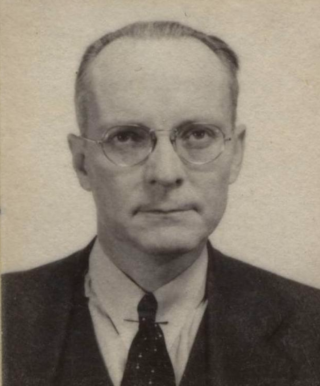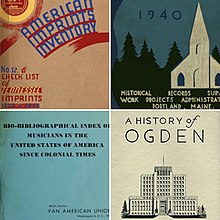
Luther Harris Evans was an American political scientist who served as the tenth Librarian of Congress and third Director-General of UNESCO.
The Rosenholz files are a collection of 381 CD-ROMs containing 280,000 files with information on persons who were sources and targets or employees and helpers in the focus of the Hauptverwaltung Aufklärung, the primary foreign intelligence agency of the former German Democratic Republic. At the beginning it was thought that the files mostly contain the real names of agents who worked for the HVA in the former West Germany, but later it became clear that at least 90% of the persons never worked for or with the HVA.

Archival science, or archival studies, is the study and theory of building and curating archives, which are collections of documents, recordings, photographs and various other materials in physical or digital formats.
Archival processing is the act of surveying, arranging, describing, and performing basic preservation activities on the recorded material of an individual, family, or organization after they are permanently transferred to an archive. A person engaging in this activity is known as an archival processor, archival technician, or archivist.
In archival science and archive administration, appraisal is a process usually conducted by members of the record-holding institution in which a body of records is examined to determine its value for that institution. It also involves determining how long this value will last. The activity is one of the central tasks of an archivist, to determine the archival value of specific records. When it occurs prior to acquisition, the appraisal process involves assessing records for inclusion in the archives. In connection with an institution's collecting policy, appraisal "represents a doorway into the archives through which all records must pass". Some considerations when conducting appraisal include how to meet the record-granting body's organizational needs, how to uphold requirements of organizational accountability, and how to meet the expectations of the record-using community.

The National Archives of Nigeria has its headquarters in Abuja, Nigeria, with branches in Enugu, Ibadan, and Kaduna.The national archives kaduna is located at yakubu gowon way sabo Gari Nasarawa 802125 Kaduna. As of 2024, the current Director of Archives is Mrs Evelyn Odigbo.

Sir Charles Hilary Jenkinson was a British archivist and archival theorist, regarded as the figure most responsible for bringing continental European concepts of archival theory to the English-speaking world.
Respect des fonds, or le respect pour les fonds, is a principle in archival theory that proposes to group collections of archival records according to their fonds. It is one of several principles stemming from provenance that have guided archival arrangement and description from the late 19th century until the present day. It is similar to archival integrity, which dictates that "a body of records resulting from the same activity must be preserved as a group." It is also closely related to the idea of original order – the idea that archivists ought to maintain records using the creator's organizational system. However, respect des fonds differs from that other foundational sub-principle of provenance in its concern with the integrity of the collection or record group as a whole rather than the organization of materials within that collection or record group.
Original order is a concept in archival theory that a group of records should be maintained in the same order as they were placed by the record's creator. Along with provenance, original order is a core tenet of the archival concept of respect des fonds. A primary goal of keeping records in their original order is to preserve additional contextual information about the records' creator and the environment of their creation. Original order also encourages the archivist to remain neutral as opposed to applying any interpretation to the records.
Robert Cedric Binkley was an American historian. As chair of the Joint Committee on Materials for Research of the Social Science Research Council and the American Council of Learned Societies in the 1930s he led several projects in the areas of publication using new near-print technologies, microphotography, copyright and archival management, many under the aegis of the Works Progress Administration. His theoretical writings on amateur scholarship and the ways non-experts could contribute to scholarship have been influential on recent thinking about digital humanities and web publishing.

Theodore Roosevelt Schellenberg was an American archivist and archival theorist. Schellenberg's publications and ideas are part of the foundation for archival theory and practice in the United States. In particular, Schellenberg is known for pioneering American archival ideas about appraisal.
"More Product, Less Process: Revamping Traditional Archival Processing" is a 2005 archival science article written by Mark A. Greene and Dennis Meissner that first appeared in the Fall/Winter 2005 issue of The American Archivist. The paper argues that traditional archival processing is too slow, and advocates for the use of minimal processing in order to reduce backlogs and provide access to archival collections as quickly as possible. The ideology presented in the article, abbreviated as MPLP, has since been widely adopted in modern archival theory with subsequent praise directed primarily towards the ability to increase user accessibility without prohibiting the option for future processing.

Mabel Evelyn Deutrich was an American archivist. In 1975 she was the highest ranking woman in the history of the National Archives.

Philip May Hamer was an American archivist and historian, and served as the executive director of the National Historical Publications Commission from 1951 to 1961.

Elizabeth "Betty" Edwards Hamer Kegan was an American archivist and librarian, and served as the Assistant Librarian of Congress from 1963 to 1978. She was a founding member of the Society of American Archivists (SAA) in 1936 and was President of SAA from 1975-1976.
The Academy of Certified Archivists is an American independent, nonprofit organization of professional archivists founded in 1989.
Sue E. Holbert was an American archivist with the Minnesota Historical Society and the Minnesota State Archivist (1979–1993). She is now the owner of Booklady Used and Rare Books in Chicago, Illinois.
Michelle Caswell is an American archivist and academic known for her work regarding community archives and approaches to archival practice rooted in anti-racism and anti-oppression. She is an associate professor of archival studies in the Department of Information Studies at University of California, Los Angeles and is the director of the school's Community Archives Lab.
Eron Rowland (1861/2–1951), born Eron Opha Moore and also known as Eron Moore Gregory, was a historian, author and the wife of Andrew E. Gregory until his death in 1900. She later married Dunbar Rowland, and authored some journal articles under the name Mrs. Dunbar Rowland. With Rowland, she helped develop the Mississippi Department of Archives and History which holds many of the family's papers.
The Council of State Archivists (CoSA) is a non-profit membership association of the United States state and territorial government archives.












